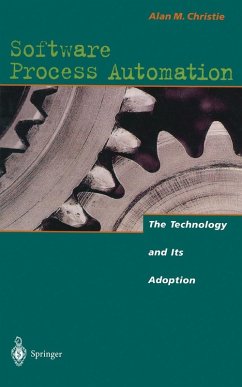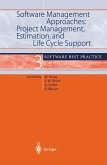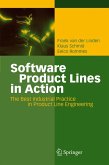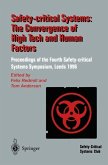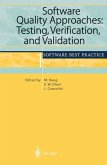40,95 €
40,95 €
inkl. MwSt.
Sofort per Download lieferbar

20 °P sammeln
40,95 €
Als Download kaufen

40,95 €
inkl. MwSt.
Sofort per Download lieferbar

20 °P sammeln
Jetzt verschenken
Alle Infos zum eBook verschenken
40,95 €
inkl. MwSt.
Sofort per Download lieferbar
Alle Infos zum eBook verschenken

20 °P sammeln
- Format: PDF
- Merkliste
- Auf die Merkliste
- Bewerten Bewerten
- Teilen
- Produkt teilen
- Produkterinnerung
- Produkterinnerung

Bitte loggen Sie sich zunächst in Ihr Kundenkonto ein oder registrieren Sie sich bei
bücher.de, um das eBook-Abo tolino select nutzen zu können.
Hier können Sie sich einloggen
Hier können Sie sich einloggen
Sie sind bereits eingeloggt. Klicken Sie auf 2. tolino select Abo, um fortzufahren.

Bitte loggen Sie sich zunächst in Ihr Kundenkonto ein oder registrieren Sie sich bei bücher.de, um das eBook-Abo tolino select nutzen zu können.
Process automation can significantly improve software quality and software development productivity. This monograph reviews the technology and the products and provides adoption guidelines for potential users.
- Geräte: PC
- ohne Kopierschutz
- eBook Hilfe
- Größe: 20.37MB
Andere Kunden interessierten sich auch für
![Software Management Approaches: Project Management, Estimation, and Life Cycle Support (eBook, PDF) Software Management Approaches: Project Management, Estimation, and Life Cycle Support (eBook, PDF)]() Software Management Approaches: Project Management, Estimation, and Life Cycle Support (eBook, PDF)40,95 €
Software Management Approaches: Project Management, Estimation, and Life Cycle Support (eBook, PDF)40,95 €![Software Product Lines in Action (eBook, PDF) Software Product Lines in Action (eBook, PDF)]() Frank J. van der LindenSoftware Product Lines in Action (eBook, PDF)40,95 €
Frank J. van der LindenSoftware Product Lines in Action (eBook, PDF)40,95 €![Software Product Lines (eBook, PDF) Software Product Lines (eBook, PDF)]() Software Product Lines (eBook, PDF)72,95 €
Software Product Lines (eBook, PDF)72,95 €![Experiences in Software Evolution and Reuse (eBook, PDF) Experiences in Software Evolution and Reuse (eBook, PDF)]() Svein HallsteinsenExperiences in Software Evolution and Reuse (eBook, PDF)40,95 €
Svein HallsteinsenExperiences in Software Evolution and Reuse (eBook, PDF)40,95 €![Safety-Critical Systems: The Convergence of High Tech and Human Factors (eBook, PDF) Safety-Critical Systems: The Convergence of High Tech and Human Factors (eBook, PDF)]() Safety-Critical Systems: The Convergence of High Tech and Human Factors (eBook, PDF)72,95 €
Safety-Critical Systems: The Convergence of High Tech and Human Factors (eBook, PDF)72,95 €![Software Engineering und Prototyping (eBook, PDF) Software Engineering und Prototyping (eBook, PDF)]() Thorsten SpittaSoftware Engineering und Prototyping (eBook, PDF)29,99 €
Thorsten SpittaSoftware Engineering und Prototyping (eBook, PDF)29,99 €![Software Quality Approaches: Testing, Verification, and Validation (eBook, PDF) Software Quality Approaches: Testing, Verification, and Validation (eBook, PDF)]() Software Quality Approaches: Testing, Verification, and Validation (eBook, PDF)40,95 €
Software Quality Approaches: Testing, Verification, and Validation (eBook, PDF)40,95 €-
-
-
Process automation can significantly improve software quality and software development productivity. This monograph reviews the technology and the products and provides adoption guidelines for potential users.
Dieser Download kann aus rechtlichen Gründen nur mit Rechnungsadresse in A, B, BG, CY, CZ, D, DK, EW, E, FIN, F, GR, HR, H, IRL, I, LT, L, LR, M, NL, PL, P, R, S, SLO, SK ausgeliefert werden.
Produktdetails
- Produktdetails
- Verlag: Springer Berlin Heidelberg
- Seitenzahl: 217
- Erscheinungstermin: 6. Dezember 2012
- Englisch
- ISBN-13: 9783642792526
- Artikelnr.: 53137679
- Verlag: Springer Berlin Heidelberg
- Seitenzahl: 217
- Erscheinungstermin: 6. Dezember 2012
- Englisch
- ISBN-13: 9783642792526
- Artikelnr.: 53137679
- Herstellerkennzeichnung Die Herstellerinformationen sind derzeit nicht verfügbar.
Process automation can significantly improve software quality and software development productivity. This monograph reviews the technology and the products and provides adoption guidelines for potential users.
1 Software Process Automation in Perspective.- 1.1 The Origins of Software Process Automation.- 1.2 Automation in a Process Improvement Context.- 1.3 A Process Development and Usage Scenario.- 2 Process Definition, Execution and Verification.- 2.1 Underlying Concepts.- 2.2 Process Definition and Executable Specification.- 2.3 The ProNet Graphical Modeling Language.- 2.4 Developing an Approach to Process Execution.- 2.5 Two Examples of Process Execution.- 2.6 Software Process Verification.- 2.7 Miscellaneous Issues.- 2.8 Summary.- 3 An Investigation into Process-Centered Environments.- 3.1 Setting a Context for PCEs.- 3.2 The Experimental Approach.- 3.3 The ProcessWeaver Experiment.- 3.4 The Synervision Experiment.- 3.5 End-User Role Plays.- 3.6 A Comparison of ProcessWeaver and Synervision.- 4 The Application of Process-Centered Environments.- 4.1 Why Use a Process-Centered Environment?.- 4.2 Issues Related to CASE and Process Improvement.- 4.3 Responses to Adopting New Technology.- 4.4 User-Oriented Issues with PCEs.- 4.5 A Transitioning Strategy.- 5 The Past, Present, and Future of Process Automation.- Appendix A The Process Enactment Program, ProSim.- A.1 The Process Controller Listing.- A.2 The codeDevel Process.- A3 The docUpdate Process.- Appendix B The Process Verification Program.- Appendix C Vendor Information on PCEs.- Appendix D Listing of SynerVision Experiment Script.- Appendix E Terminology and Concepts.- E.1 Basic Terminology.- E.2 Process-Related Concepts.- E.3 Relationship to the NIST/ECMA Reference Model.- Appendix F End-User Evaluation Materials.- References.
1 Software Process Automation in Perspective.- 1.1 The Origins of Software Process Automation.- 1.2 Automation in a Process Improvement Context.- 1.3 A Process Development and Usage Scenario.- 2 Process Definition, Execution and Verification.- 2.1 Underlying Concepts.- 2.2 Process Definition and Executable Specification.- 2.3 The ProNet Graphical Modeling Language.- 2.4 Developing an Approach to Process Execution.- 2.5 Two Examples of Process Execution.- 2.6 Software Process Verification.- 2.7 Miscellaneous Issues.- 2.8 Summary.- 3 An Investigation into Process-Centered Environments.- 3.1 Setting a Context for PCEs.- 3.2 The Experimental Approach.- 3.3 The ProcessWeaver Experiment.- 3.4 The Synervision Experiment.- 3.5 End-User Role Plays.- 3.6 A Comparison of ProcessWeaver and Synervision.- 4 The Application of Process-Centered Environments.- 4.1 Why Use a Process-Centered Environment?.- 4.2 Issues Related to CASE and Process Improvement.- 4.3 Responses to Adopting New Technology.- 4.4 User-Oriented Issues with PCEs.- 4.5 A Transitioning Strategy.- 5 The Past, Present, and Future of Process Automation.- Appendix A The Process Enactment Program, ProSim.- A.1 The Process Controller Listing.- A.2 The codeDevel Process.- A3 The docUpdate Process.- Appendix B The Process Verification Program.- Appendix C Vendor Information on PCEs.- Appendix D Listing of SynerVision Experiment Script.- Appendix E Terminology and Concepts.- E.1 Basic Terminology.- E.2 Process-Related Concepts.- E.3 Relationship to the NIST/ECMA Reference Model.- Appendix F End-User Evaluation Materials.- References.
